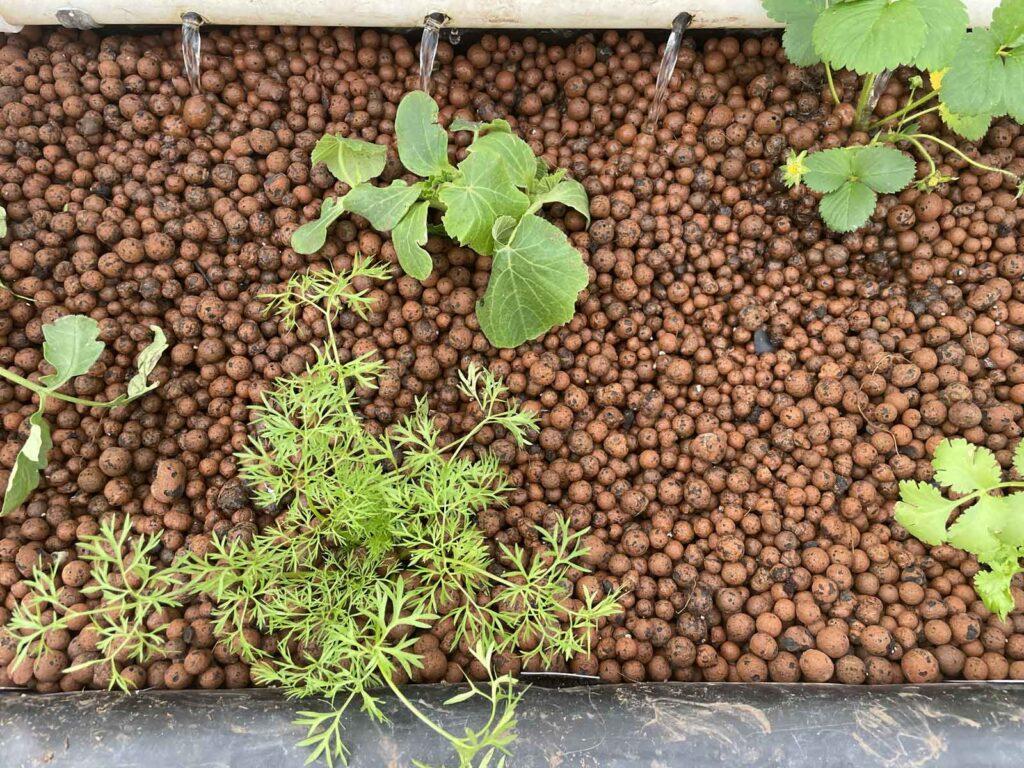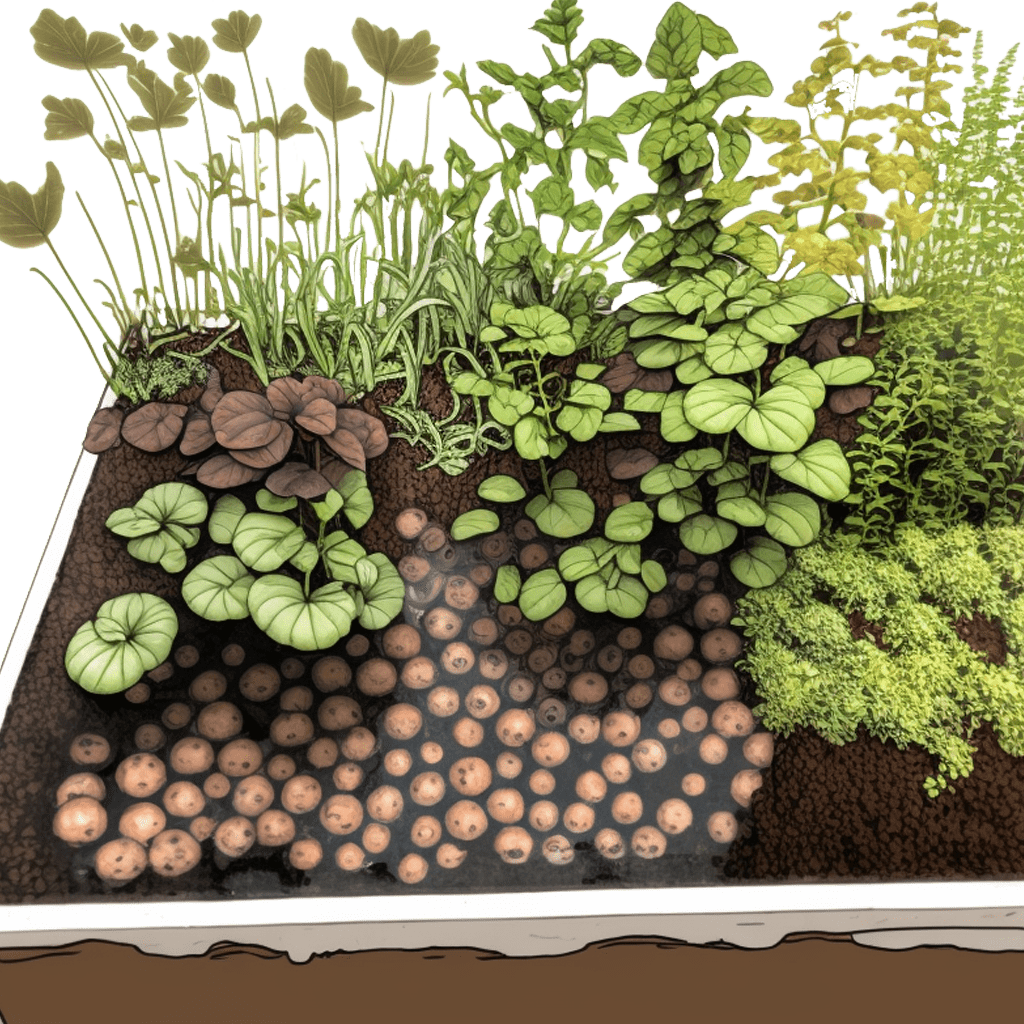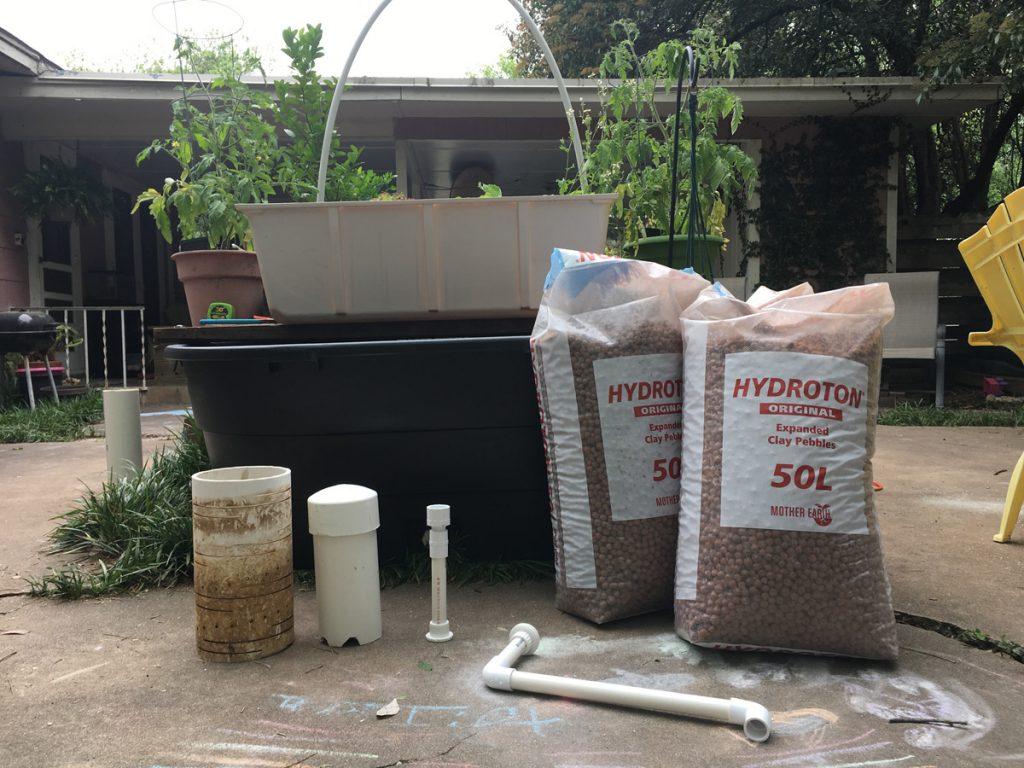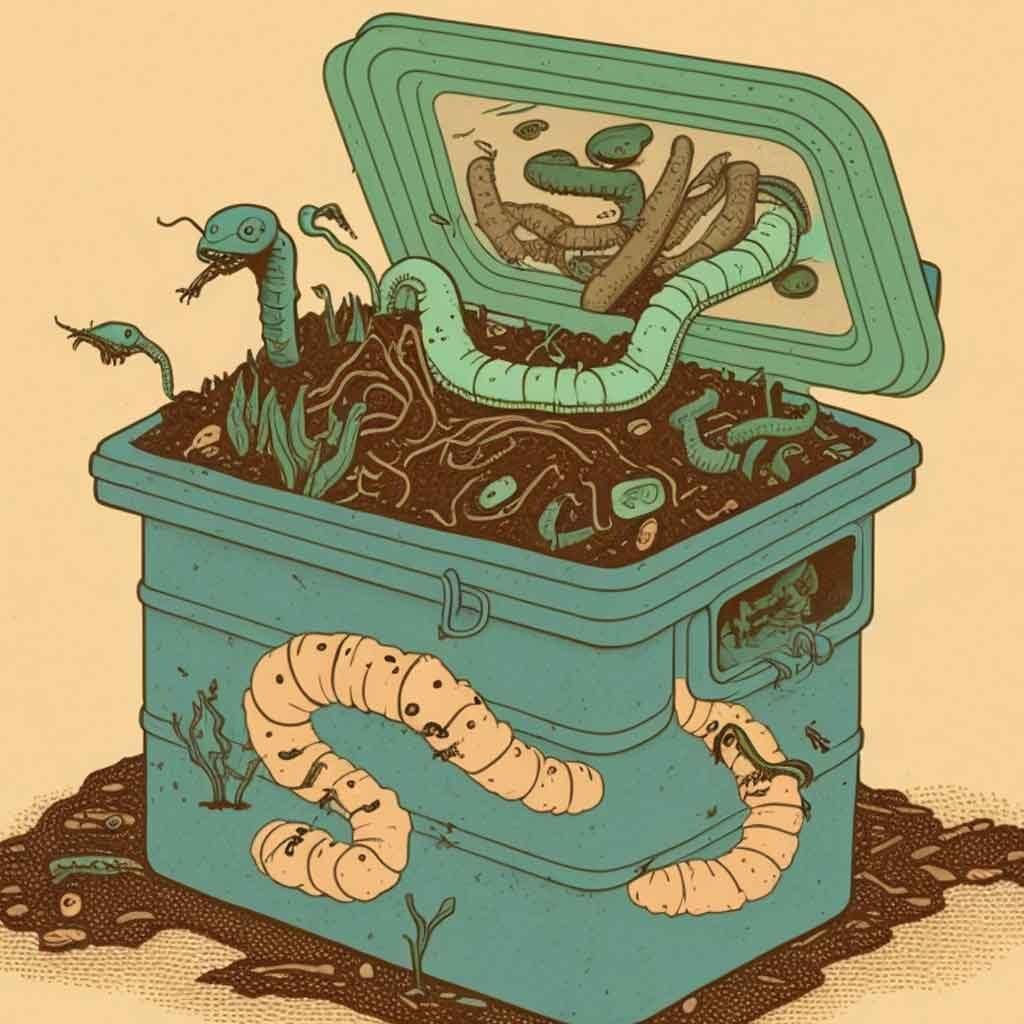Aquaponics is an innovative farming system that combines aquaculture (raising fish) and hydroponics (growing plants in water) in a symbiotic relationship. In aquaponics, fish waste provides a natural source of nutrients for plants, which in turn filter the water for the fish. This mutually beneficial process results in a closed-loop system that uses less water, produces healthier crops, and requires fewer inputs than traditional farming methods.
Media-based systems are one of the most popular types of aquaponics setups, and they offer several benefits for both the fish and the plants. In this article, we’ll take a closer look at media-based systems and explore why they’re such a powerful tool for sustainable agriculture.

What is a Media-Based Aquaponics System?
A media-based aquaponics system is a type of setup that uses a substrate, or “media,” to provide a surface area for beneficial bacteria to colonize. These bacteria are essential to the aquaponic ecosystem, as they convert the fish waste into a form of nitrogen that plants can use. Without these bacteria, the water would quickly become toxic for the fish and the plants would suffer from nutrient deficiencies.
The media in a media-based system can take many forms, but the most common types are expanded clay pebbles, lava rock, and gravel. These materials provide a porous surface area that allows water to flow through and provide oxygen to the bacteria. The media also provides stability for the plants, as their roots can anchor themselves in the substrate and access the nutrients they need.
Advantages of Media-Based Aquaponics Systems

Media-based aquaponics systems have several advantages over other types of setups, including:
- Increased plant growth: Media-based systems provide a stable environment for plant roots, which allows them to grow larger and access more nutrients. This results in faster growth rates and higher yields.
- Improved water quality: The media in a media-based system acts as a natural filter, removing harmful toxins and pathogens from the water. This results in a healthier environment for both the fish and the plants.
- Increased biodiversity: Media-based systems provide a habitat for beneficial bacteria, which are essential to the aquaponic ecosystem. These bacteria can also attract other beneficial organisms, such as worms and insects, which can help improve soil health and plant growth.
- Increased flexibility: Media-based systems are highly customizable, allowing growers to adjust the size, shape, and layout of their system to fit their specific needs. This makes them ideal for both commercial and hobbyist growers.
How to Set Up a Media-Based Aquaponics System

Setting up a media-based aquaponics system can be relatively simple, depending on the size and complexity of the setup. Here are the basic steps:
- Choose a suitable location: The location of your aquaponics system is important, as it will affect factors such as temperature, lighting, and accessibility. Choose a location that receives ample sunlight, is protected from wind and other elements, and is easy to access for maintenance.
- Select your tank and media: Choose a tank that is large enough to house the number of fish you want to raise, and select a suitable media for your system. Expanded clay pebbles, lava rock, and gravel are all good options.
- Install your plumbing: You’ll need to install plumbing to circulate water between the fish tank and the grow bed. This can be done using PVC pipes, pumps, and valves.
- Add your fish: Choose a suitable species of fish for your system, and add them to the tank. Make sure to monitor water quality and temperature to ensure their health.
- Plant your crops: Once your system is cycled (meaning the beneficial bacteria have established themselves), you can add your plants to the grow bed. Make sure to choose species that are suitable for aquaponics and adjust your pH and nutrient levels as needed.
- Monitor and maintain your system: Regular monitoring and maintenance are essential to keeping your aquaponics system healthy and productive. This includes testing water quality, checking for signs of disease or nutrient deficiencies, and performing regular maintenance on your equipment.
Disadvantages to media-based aquaponics systems
While media-based aquaponics systems offer numerous advantages, there are also some potential disadvantages to consider:
- Initial setup cost: Setting up a media-based aquaponics system can be expensive, especially if you’re starting from scratch. You’ll need to purchase a tank, plumbing materials, grow media, and other equipment, which can add up quickly.
- Complexity: Media-based systems can be more complex to set up and maintain than other types of aquaponics setups. You’ll need to monitor water quality, pH, and nutrient levels, and adjust these factors as needed to ensure optimal growth.
- Limited fish options: Some fish species are better suited to aquaponics than others, which can limit your options for raising fish. You’ll need to choose a species that can thrive in the conditions of your system, which can be challenging for beginners.
- Energy usage: Media-based systems require pumps to circulate water between the fish tank and grow bed, which can use a significant amount of energy. This can increase your energy costs and carbon footprint.
- Risk of disease: Like any farming system, aquaponics is susceptible to disease and pests. If you don’t maintain proper water quality and sanitation, you may experience outbreaks of disease or pest infestations that can harm your plants and fish.
Overall, while media-based aquaponics systems offer numerous benefits, they may not be the right choice for everyone. It’s important to weigh the advantages and disadvantages carefully and choose a system that meets your needs and resources. With proper planning and maintenance, however, media-based aquaponics systems can be a highly rewarding and sustainable way to grow your own food.
Ebb and Flow Media-Based Aquaponics Systems
Ebb and flow media-based aquaponics systems, also known as flood and drain systems, are a type of media-based system that uses a grow bed filled with a substrate such as expanded clay pebbles or gravel. These systems are designed to flood the grow bed with water and nutrients periodically, allowing the plants to absorb the nutrients they need and providing a natural filter for the fish tank.
How Ebb and Flow Systems Work
In an ebb and flow media-based aquaponics system, water is pumped from the fish tank into the grow bed, which is filled with a substrate. The water and nutrients flow through the substrate and are absorbed by the plant roots, which filter the water and return it to the fish tank. The excess water drains back into the fish tank, creating a continuous cycle of nutrient-rich water.
Advantages of Ebb and Flow Systems
Ebb and flow media-based aquaponics systems offer several advantages over other types of systems, including:
- Reduced water usage: Ebb and flow systems use less water than other types of aquaponics setups, as the water is recycled through the system and there is less evaporation.
- Increased plant growth: The flood and drain cycles in ebb and flow systems allow the plants to absorb nutrients more efficiently, which can result in faster growth and higher yields.
- Improved water quality: The substrate in the grow bed acts as a natural filter, removing harmful toxins and pathogens from the water and creating a healthier environment for the fish and plants.
- Customizable: Ebb and flow systems can be customized to fit a wide range of setups, from small hobby systems to large commercial operations.
Setting Up an Ebb and Flow System
Setting up an ebb and flow media-based aquaponics system is similar to setting up other types of media-based systems. You’ll need to select a suitable substrate, install plumbing to circulate water between the fish tank and grow bed, and choose appropriate fish and plants for your system.
One important factor to consider when setting up an ebb and flow system is the timing and duration of the flood and drain cycles. The cycle duration should be long enough to allow the plants to absorb the nutrients they need, but not so long that the roots become waterlogged or starved of oxygen. A cycle duration of 15-30 minutes is usually sufficient for most setups.
Media-based aquaponics systems offer an efficient and sustainable method of food production that has the potential to revolutionize the way we grow our food. By combining aquaculture and hydroponics in a closed-loop system, media-based aquaponics systems provide numerous benefits for both the fish and the plants.
With the right setup and maintenance, media-based aquaponics systems can provide a reliable source of fresh, healthy produce and fish, while also reducing water usage and minimizing the need for external inputs. If you’re interested in sustainable agriculture and want to explore new ways of growing your own food, a media-based aquaponics system may be just what you need.
Frequently Asked Questions about Media-Based Systems
Can media-based aquaponics systems be used to grow any type of plant?
Media-based aquaponics systems can be used to grow a wide variety of plants, including herbs, vegetables, and fruits. However, some species may be more challenging to grow than others, and may require specific pH or nutrient levels to thrive.
How much space do I need to set up a media-based aquaponics system?
The amount of space you need will depend on the size and complexity of your system. For a small home system, you may only need a few square feet of space. Commercial systems can require several hundred or even thousands of square feet.
What types of fish are suitable for media-based aquaponics systems?
Some of the most common fish species used in media-based aquaponics systems include tilapia, trout, and catfish. However, other species such as perch and bass can also be used, depending on the conditions of your system.
Can I use tap water in my media-based aquaponics system?
Yes, you can use tap water in your media-based aquaponics system, but you’ll need to dechlorinate it first. Chlorine and other chemicals found in tap water can harm the beneficial bacteria in your system, so it’s important to remove these before adding the water to your tank.
How often do I need to check the water quality in my media-based aquaponics system?
You should check the water quality in your media-based aquaponics system at least once a week, but ideally more often. Testing for pH, ammonia, nitrite, and nitrate levels can help you identify and address any issues before they become a problem.
What are the best crops to grow in a media-based aquaponics system?
Some of the best crops for media-based aquaponics systems include lettuce, herbs, strawberries, and tomatoes. These crops are relatively easy to grow and can thrive in the conditions of an aquaponic system.
Can I use fish waste from a media-based aquaponics system as fertilizer for other plants?
Yes, fish waste from a media-based aquaponics system can be used as a natural fertilizer for other plants, such as those grown in a traditional soil-based garden.
How long does it take for a media-based aquaponics system to cycle?
The cycling process for a media-based aquaponics system typically takes 4-6 weeks. During this time, beneficial bacteria establish themselves in the system and begin converting fish waste into plant nutrients.
How much fish can I raise in a media-based aquaponics system?
The amount of fish you can raise in a media-based aquaponics system will depend on the size of your tank and the conditions of your system. As a general rule of thumb, you can raise one pound of fish per ten gallons of water.
Can I automate my media-based aquaponics system?
Yes, many media-based aquaponics systems can be automated using timers, sensors, and other equipment. This can help you monitor and control the conditions of your system more efficiently, and make it easier to maintain over time.
References for further reading on media-based aquaponics systems:
- Food and Agriculture Organization of the United Nations. (2014). Small-scale aquaponic food production: Integrated fish and plant farming. http://www.fao.org/3/a-i4021e.pdf
- Rakocy, J. E., Masser, M. P., & Losordo, T. M. (2006). Recirculating aquaculture tank production systems: Aquaponics—integrating fish and plant culture. Southern Regional Aquaculture Center.
- Resh, H. M. (2013). Hydroponic food production: A definitive guidebook for the advanced home gardener and the commercial hydroponic grower. CRC Press.
- Somerville, C., & Rusten, B. (2019). An Introduction to Aquaponics. Food and Agriculture Organization of the United Nations. http://www.fao.org/3/i8474en/i8474en.pdf
- University of Arizona. (n.d.). Aquaponics. https://acbs.cals.arizona.edu/aquaponics




Leave a Reply